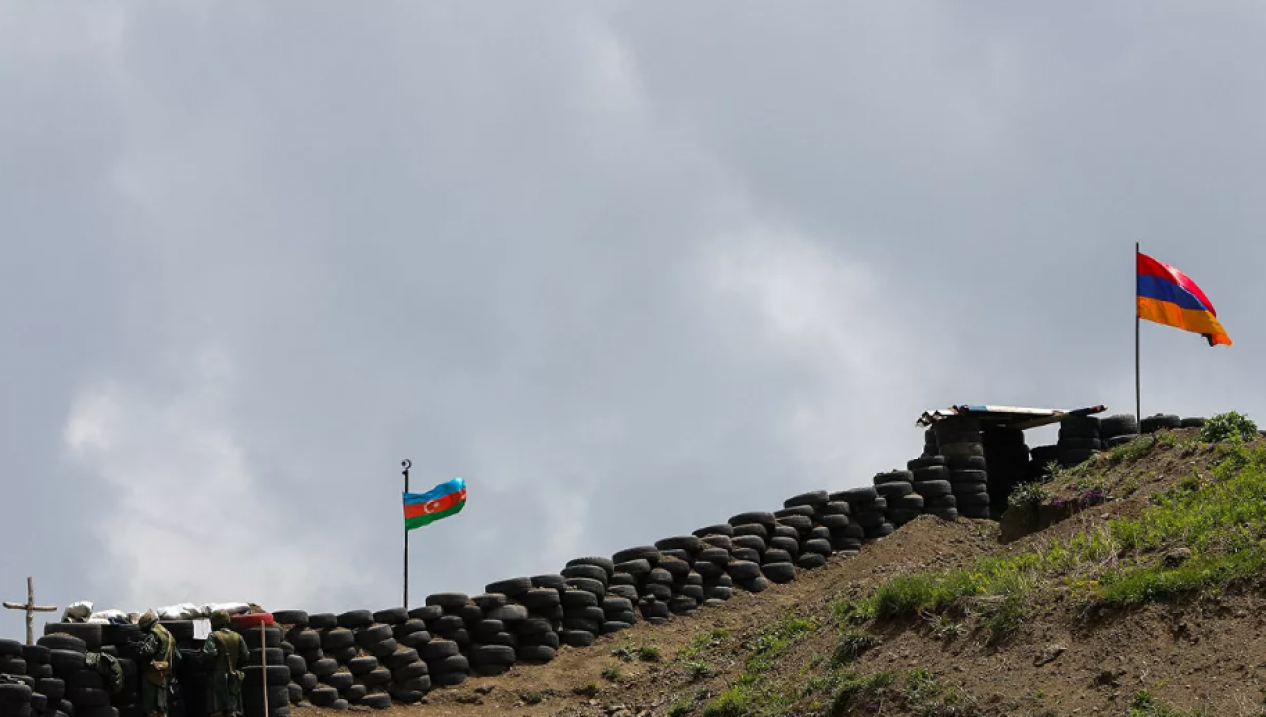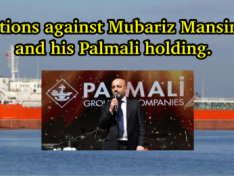
Laurence Broers, Caucasus program director at London-based peacebuilding organization Conciliation Resources, has published an article in Chatham House entitled "With Russia distracted, Azerbaijan escalates in Karabakh."
Faktyoxla Lab. has tried to shed the light on some of the conclusions and arguments of the British expert.
- The author writes that “since Russia invaded Ukraine, Azerbaijan has increasingly tested the will and capacity of the Russian peacekeeping mission deployed to the residual territory remaining under Armenian control at the end of the 2020 Karabakh war. In early March, Azerbaijani forces were observed circling close to Armenian villages with loudspeakers urging the inhabitants to evacuate, and reports of increased ceasefire violations soon followed… Azerbaijani forces then advanced into the area which is ostensibly under Russian peacekeeper control, forcing the evacuation of one Armenian village, taking strategic heights overseeing others, and reportedly using drone strikes to kill three local Armenian servicemen and wound a further 15.”
- indeed, on March 24, the Armenian media and telegram channels began to distribute a video and information that the Azerbaijanis allegedly demanded that the residents of the Karabakh village of Pirlar (Khramort) in the Khojaly region of Azerbaijan leave their homes: "The "message" of the Azerbaijanis said that if the inhabitants do not leave the territory, force will be used against them, since all actions on this land are regulated by the laws of Azerbaijan."
But upon careful study of this video, it turned out that indeed, the servicemen of the Azerbaijani Armed Forces, through loudspeakers, broadcast the following text through the loudspeaker: “Appeal to citizens of Armenian nationality! You are on the territory of the Republic of Azerbaijan. Here, any activity is regulated by the laws of Azerbaijan.
Anything you do without official permission is illegal. Your current engineering work is illegal. Do not prepare for war and do not try to build a border on our territory! If you want to live here, follow the laws of Azerbaijan! For your safety, stop work and leave the area immediately. Otherwise, force will be used against you. You are responsible for your losses. Do not endanger yourself and your families! Get out of the area!"
That is, it was about the fact that the Armenians are carrying out some kind of engineering work on the territory of this village, or rather they are digging trenches, etc., and are trying to build a border, which is why the calls “Stop work” were heard. The order to "immediately leave the territory" is addressed specifically to them, and not to all the inhabitants of the village. And the order "Leave the territory" does not mean "Leave the village." The video shows trenches, right next to which a truck with a loudspeaker drove up. And most importantly, the trenches were dug far from the village. Thus, it was required to leave a specific territory, and not the village. In a word, there were no "calls for the villagers to evacuate," as the British expert writes.
- with regard to the statement that " Azerbaijani forces then advanced into the area which is ostensibly under Russian peacekeeper control, forcing the evacuation of one Armenian village, taking strategic heights overseeing others, and reportedly using drone strikes to kill three local Armenian servicemen and wound a further 15", the first information about this appeared on the official website of the Ministry of Defense of the Russian Federation on March 26 this year.
In particular, it said that “from March 24 to March 25, the Azerbaijani armed forces, violating the provisions of the trilateral statement of the leaders of Russia, Azerbaijan and Armenia dated November 9, 2020, entered the zone of responsibility of the Russian peacekeeping contingent in the territory of Nagorno-Karabakh and set up an observation post.”
“Four strikes were inflicted by a Bayraktar-TB 2 type drone on units of the armed formations of Nagorno-Karabakh in the area of the FURUKH (Parukh) settlement. Currently, the command of the Russian peacekeeping contingent is taking measures to resolve the situation and return the troops to their original position. The Azerbaijani side was urged to withdraw their troops,” the Russian Defense Ministry said in a statement.
The Azerbaijani Defense Ministry expressed its regret in connection with the one-sided statement of the Ministry of Defense of the Russian Federation dated March 26, 2022.
“The Ministry of Defense of the Republic of Azerbaijan expresses regret regarding the one-sided statement of the Ministry of Defense of the Russian Federation dated March 26, 2022, which does not reflect the reality. However, in the morning of March 26, members of illegal Armenian armed detachments attempted to sabotage the Azerbaijan Army Units. As a result of immediate measures, members of illegal Armenian armed detachments were forced to retreat.
The Defense Ministry states that Azerbaijan is committed to the Joint Statement of November 10, 2020 and has not violated any of the provisions.
We regrettably inform that the withdrawal of the remnants of the Armenian army and illegal Armenian armed detachments from the territory of Azerbaijan in accordance with article 4 of this Statement has not yet been completed. Therefore, it is Armenia, not Azerbaijan, that violates the provisions of the Statement.
The Ministry of Defense states that the statement of the Ministry of Defense of the Russian Federation contradicts the essence of bilateral relations and the Declaration on Allied Interaction signed between the two countries on February 22, 2022.
There is no administrative and territorial unit called "Nagorno-Karabakh" in the territory of Azerbaijan. The name of the village mentioned in the statement is not Furukh, but Farrukh.
Regarding this, the Ministry of Defense of the Republic of Azerbaijan requests the Ministry of Defense of the Russian Federation to completely withdraw the remnants of the Armenian army and illegal Armenian armed detachments from the territory of Azerbaijan recognized by the international community in accordance with the provisions of the Joint Statement, asks not to use the term "Nagorno-Karabakh" and correctly indicate the names of the territories of Azerbaijan,” the Azerbaijani Defense Ministry said in a statement.
It turns out that the Russian Defense Ministry characterize the Armenian militants located in their zone of responsibility on the territory of Azerbaijan as "divisions of the armed formations of Nagorno-Karabakh." Azerbaijan demands clarification why are armed people, regardless of their status, generally located on the sovereign territory of Azerbaijan, temporarily under the control of the Russian peacekeeping contingent?
- The author writes that “Azerbaijan has leveraged Article 4 of the 9 November 2020 ceasefire statement, stipulating the withdrawal of Armenian troops, to justify its actions. But although 3,000 troops from Armenia reportedly did leave after the ceasefire agreement, the statement’s wording leaves the status of local Karabakh Armenian forces – the self-styled Nagorno-Karabakh Defense Army – as ambiguous. Baku sees them as an illegal armed group on its territory, but the local authorities and population see them as essential self-defense. Yet with local Karabakh Armenian units being no match for the Azerbaijani army, it is only Russian peacekeepers that stand between Azerbaijani forces and Karabakh Armenian civilians.”
- Indeed, the withdrawal of all Armenian armed forces is a prerequisite for the tripartite statement on Karabakh by the President of the Republic of Azerbaijan, the Prime Minister of the Republic of Armenia and the President of the Russian Federation dated November 10.
This is written clearly in paragraph 4 of the document.
The peacemaking forces of the Russian Federation shall be deployed concurrently with the withdrawal of the Armenian troops. The peacemaking forces of the Russian Federation will be deployed for five years, a term to be automatically extended for subsequent five-year terms unless either Party notifies about its intention to terminate this clause six months before the expiration of the current term.
According to the common logic, as well as according to the letter of the tripartite statement on Karabakh, not a single armed Armenian should have remained in these territories of Azerbaijan. However, they not only remained there, in all likelihood, during this time support repeatedly arrived from Armenia.
- It is not clear where the author got the information about "3,000 troops from Armenia reportedly did leave after the ceasefire agreement", and what does the "the status of local Karabakh Armenian forces – the self-styled Nagorno-Karabakh Defense Army" mean? Again, the question arises, if the so-called local authorities and the population allegedly see these illegal armed formations as necessary self-defense, then why does the British expert further write that "local Karabakh Armenian units being no match for the Azerbaijani army"? If this is so, it turns out that these formations aren’t needed at all if, as the author writes, "it is only Russian peacekeepers that stand between Azerbaijani forces and Karabakh Armenian civilians"?
To understand their absurdity of the quoted words of the British expert, it is enough to return to the well-known document once again. The fact is that the joint Statement of the Presidents of Azerbaijan, Russia and Armenian Prime Minister quite specifically prescribes the withdrawal of all Armenian armed forces in parallel with the deployment of Russian peacekeepers along the line of contact in Nagorno-Karabakh and along the Lachin corridor. This is clearly written in paragraph 4 of the document.
It turns out that on November 10, 2020, the parties agreed to cease hostilities, on November 20, the peacekeeping contingent of the Russian Armed Forces completed its deployment in its area of responsibility, and the Armenian armed formations not only didn’t leave the Azerbaijani territories liberated from occupation, but also attacked the positions of the Azerbaijani military.
- The author writes about "the status of the local Karabakh Armenian forces - the self-proclaimed Defense Army of Nagorno-Karabakh", everything is very clear here.
The so-called "Nagorno-Karabakh Defense Army" and the Armed Forces of Armenia are not two different structures, and it is no secret that they are two components of one whole. The Armenians themselves have repeatedly recognized that the so-called Defense Army is deeply integrated into the Armed Forces of Armenia.
The provision of the so-called defense army of the "NKR" with weapons and military equipment, the training of military personnel was carried out by the Ministry of Defense of Armenia. And most importantly, young people who are citizens of Armenia have regularly served in military units in the occupied territories of Azerbaijan since the beginning of the First Karabakh War. A third of the "defense army" of the “NKR”, and according to some sources, half of its personnel were conscripts from Armenia.
During the Second Karabakh War, Armenian Prime Minister Nikol Pashinyan announced military mobilization and called for active military service of reservists. There are enough facts that many Armenians came to Karabakh as part of the mobilization of people aged 18-55. In addition, on October 5, 2020, Pashinyan again appealed to military personnel who were dismissed last year, that is, in 2019, to enlist in the army. Calling them “the most successful source of mobilization,” Pashinyan said that there are 10,000 such young people in Armenia. In the following days, Pashinyan appealed to members of municipalities, city halls and political parties to “defend the Motherland.”
Where are the guarantees that these people are still not on the territory that is temporarily under the control of Russian peacekeepers?
- The author writes that “Ambivalence towards Azerbaijan’s territorial integrity is widely framed by Azerbaijani analysts as evidence of islamophobia and orientalism. While degrees of islamophobia and orientalism are also likely present in certain external perspectives on Azerbaijan, international ambivalence over Nagorny Karabakh relates to rather dim prospects of there being alternative scenarios to more ethnic cleansing – this time of the Karabakh Armenian population – as a final ‘resolution’ of the conflict.”
- in fact the conflict between Armenia and Azerbaijan has always had a biased perception in the Western media, partly caused by religious perception, partly by an ideological split. The strong Armenian diaspora and lobbying organizations present in Western society have contributed to the spread of a certain narrative about the history and current trend of the conflict. Despite that for almost thirty years the internationally recognized territory of Azerbaijan was under Armenian occupation, the Western media often portrayed the conflict as a liberation movement of the Christian people against Muslim Azerbaijan. Such a distortion was predetermined by a strong orientalist bias, and was reinforced by the growth of Islamophobia and Turkophobia.
- As for, as the author puts it, the ethnic cleansing of the Armenian population of Karabakh, on September 27 last year, President of Azerbaijan Ilham Aliyev gave an interview to the Anadolu Agency, where, in particular, he emphasized that Azerbaijan recognizes the Armenians living there as its citizens.
“As I said, and I want to repeat, that we consider the Armenians living there our citizens. They live and have always lived on Azerbaijani soil. Karabakh has always been Azerbaijan – both in Soviet times and before that. During the occupation, it was also Azerbaijan. We consider them citizens of Azerbaijan, they simply need to accept this and save their loved ones from Armenian propaganda. They should build their future, the future of their children. We will be ready to involve them in this work. Why not? “…” 25,000 Armenians live in Karabakh. They, too, can take part in these matters – both in construction and restoration work. In addition, we will create conditions for them in the places and villages where they live in the future. “…” After the occupation, after the Victory, I made dozens of trips to the regions and was horrified by the picture I saw in some of the villages where the Armenians used to live. In other words, it is a situation that is unbecoming of man. Housing in some villages is currently being analyzed, 95 percent of it is unusable. In other words, no one can live there, so they must be demolished. So a community that has lived in such a humiliating environment for 30 years naturally wants to see a light that will come only from Azerbaijan. One has to understand that this is not an easy issue for them either. The psychological state should also be taken into account here. But in any case, we are showing goodwill, and I do hope they will understand that their happy future, their prosperous future is connected only with the Azerbaijani state.”
And finally, the violation by Armenia and the Russian peacekeepers of the November 9 agreement that ended hostilities in Karabakh gives Azerbaijan the right to once again resort to military force to make the other side respect Azerbaijan’s territorial integrity within internationally recognized borders. The outcome of such a course of events does not bode well for Armenia and its puppet separatist regime, due to the multiple superiority in the military power of Azerbaijan, which was demonstrated during the Second Karabakh War. It is time for the Armenian side to reason with revanchist sentiments before they lead to tragic consequences.




















